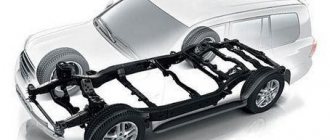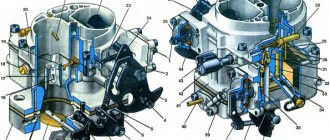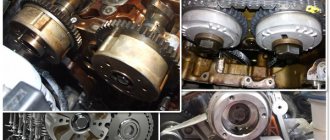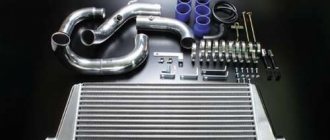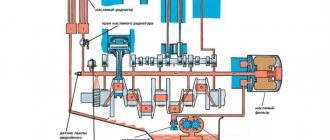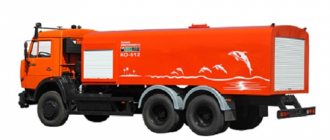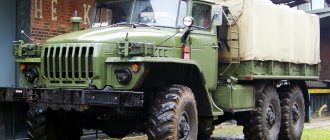Functionally, any car can be considered as a set of passenger and cargo compartments, as well as all the mechanisms and structures that allow the vehicle to move, that is, the body and chassis.
Historically, the engine has been separated into an independent unit, not related to the chassis, although structurally it is also always mentioned in its composition.
What is a chassis
All motor vehicles consist of three main components:
- power point;
- body;
- chassis.
The chassis is not a specific part of a vehicle. Sometimes this term is used to refer to the supporting structure of the machine.
In fact, the chassis is a set of mechanisms that interact with the wheels and supports of the car. This is a unit that combines the car's steering, its transmission, shock absorption system and chassis. All these systems are connected on a common basis, and their operation is synchronized so that the entire vehicle can move. The chassis also includes the frame plus powertrains - engine, transmission and suspension. There is a body on it that gives the car a finished look.
A car chassis also means a set of parts and assemblies on which the movement and maneuvers of the vehicle depend. In the technical documentation of the car, it is marked, which in this case corresponds to the body number (what is the chassis number).
The main components of the car chassis are two suspensions - front and rear, as well as wheels. Suspensions are necessary to soften or eliminate vibrations when driving, thanks to which the car smoothly overcomes all road irregularities.
Brake system
Allows you to slow down the movement of the car, until it comes to a complete stop. The system is indispensable during emergency situations, as well as when the car needs to be kept from spontaneously moving down. Car brakes include several subsystems: manual, spare, auxiliary, and anti-lock. Their combination is called braking control.
The task of the main braking system is to regulate the speed of the car and stop the vehicle if necessary. It consists of a drive and actuators (drum, disk). On modern passenger cars, a hydraulic drive is more often used, less often - electric, pneumatic or combined options. In some cases, a vacuum booster and regulator are used to increase fluid pressure and braking efficiency.
If the main brake fails or malfunctions (depressurization of one of the circuits and the fluid level drops to critical), the backup brake system is activated. It works as a stand-alone unit or in conjunction with a handbrake.
A manual or parking brake equipped with a mechanical drive is intended for:
- holding the car on descents;
- emergency braking in emergency situations.
Deceleration efficiency coefficients for a vehicle moving at a speed of 80 km/h with a pedal force of up to 50 kg of the main system and subsystems:
- main brake - not less than 5.8 m/s2;
- emergency and manual - 2.75 m/s2.
The principle of operation of brakes is simple. After pressing the pedal, the braking force is transmitted to the wheel mechanisms. The latter press the pads against the discs, thereby stopping rotation.
How it works and why it is needed
All units necessary for movement are mounted on the base of the car in such a way that rotational energy is transferred from the engine to the drive wheels. This is how the work of all nodes is synchronized:
- The motor is mounted on the subframe. From it, torque is transmitted to the front or rear axle (in the case of all-wheel or rear-wheel drive). Thanks to this, the wheels begin to rotate, and the car moves forward or backward.
- In order for the car to change its direction, a steering control is connected to it. The drive wheels set the car in motion, and the steering wheels give it direction. This unit has many parts that provide smooth maneuvers while driving.
- To change the speed of the vehicle, a gearbox is installed between the power unit and the drive wheels. It can be mechanical or automatic. In this unit, with the help of a set of gears, the torque is increased, which allows you to remove excessive load from the engine.
- When driving on roads of varying quality, vibrations occur. Due to shaking and vibration, components of the transmission and steering will quickly fail. To compensate for this load, levers and shock absorbers are attached to the subframe.
As you can see, the car chassis allows you to set the entire structure in motion, change its direction and compensate for the loads from vibrations that occur during driving. Thanks to this development, the energy generated by the internal combustion engine can be used for the comfortable and safe transportation of people and large loads.
Brief overview of important systems and components of a car device
So, according to the general design of the machine, it works as follows.
Thanks to the body, all components of the device are assembled together. The systems work synchronously and smoothly. The battery is responsible for starting the engine. The latter produces a spark, which ignites the gasoline in the combustion chamber. Detonation starts the movement of the pistons in the engine. The engine, with the help of a transmission (to put it as simply as possible, is the force that turns the wheels) transmits energy to the wheels. The chassis is responsible for the smoothness and correctness of the ride. The car is moving or stopping. These processes are controlled by the gas and brake pedals. In cars with a manual transmission there is also a clutch pedal (more on this below). In order for all the lights and sensors to work, as well as for the on-board computer to function properly, the generator generates current.
The driver, sitting behind the wheel in a comfortable cabin, does not see or feel all the complexity of the technical structure of the car. He just turns the key in the lock, shifts the gearbox lever, presses the pedals, turns the steering wheel, and presses the buttons on the panel. Well, it also controls the fuel level in the tank. A fairy tale, and nothing more!
However, still, if he wants to understand the structure of the car, at least at the “beginner” level, he must understand some more mechanisms.
- An important element of the circuit and structure of a car is the engine (or motor). They are internal combustion (gasoline or gas) and electric. The first ones are divided into a dozen more subspecies, but we won’t go deeper there.
- An equally important part of control is the braking system. It can be parking (to fix the car on an uneven surface) and working (designed to temporarily or completely stop, as well as to reduce the speed);
- Transmission. We are talking about the terms familiar to every driver: “manual” or “automatic”, if correctly - manual transmission and automatic transmission. There is also a robotic box (some mix of the first two), but it is not widely used. An automatic transmission is easier to drive, since it itself controls the speed and load on the car; such a car does not have a clutch pedal. In the case of a manual transmission, the driver, with the help of the latter, independently switches gears, monitoring the load on the car.
What is clutch? How does this element of the device work? Have you ever wondered why, when we start a car, it doesn’t drive right away? Why does it stand still when the engine is running until we change the gear and press the gas pedal (brake and clutch, then gas with manual transmission)? Now let's try to explain:
- The power unit (engine) of a car is equipped with a flywheel and crankshaft. In fact, there is a complex system of gears, shafts and teeth inside, but to delve into the details of this design, you need to have at least a minimum amount of special knowledge. Therefore, we try to explain it more simply.
- A gearbox with a clutch is attached to the engine on the flywheel side.
- The car is started in “neutral” (neutral gear), in which the crankshaft teeth are disengaged. In other words, the box shaft rotates idle, the torque is not yet transmitted to the wheels.
- To start moving, you need to depress the clutch. It will provoke a smooth articulation of the flywheel gears with the transmission. Next, you should turn on the first speed. The entire mechanism will begin to move, you can press the gas pedal. In cars with automatic transmission, this entire process is performed automatically, without driver intervention.
Well, we have analyzed the basic design elements and devices of a modern car, and tried to explain everything as clearly and simply as possible. Now you understand how the car drives, why the engine works, what this or that unit is responsible for.
Few would argue that driving a modern car, especially with an automatic transmission, is a pleasure. But this is only possible if you follow the care recommendations, treat the car with care, undergo maintenance on time and respond to the slightest malfunction.
Device
So, the chassis refers to the combination of the supporting part and some key components that allow the vehicle to move independently. All types of structures are divided into two categories.
The first category includes all cars with a frame structure. In this case, the car trolley consists of a frame to which all units, mechanisms and structures are attached. Such cars are heavy and have maximum strength. This design is mainly used in trucks and full-fledged SUVs.
The second category includes the type of chassis, which is immediately part of the car body. The supporting body is not as strong as in the case of a full frame, but it is very light, which is of great importance for passenger cars. Only with this modification of the chassis is it possible to create the lightest possible supercars.
Engineers from different automakers develop their own designs of load-bearing bodies, which differ not only in design features, but are also made from different materials.
Here is a short video that uses Mazda models as an example to show how important the use of lightweight chassis materials is for a modern car:
Mazda. Body and chassis.
Know your heart
That is, how does everything happen in reality? For example, engineers from KamAZ, or GAZ or Volvo have developed a new model. A cabin with many improvements, a new high-power engine coupled with a modernized transmission. Braking system, electrical equipment, etc. The test results turned out to be an interesting car. But it will see the light without any body in the form of a truck tractor. At best, it will receive an on-board platform. The design, creation and installation of add-ons will be handled by completely different specialists. In the West they are called bodybuilder.
Li Wenming, General Director of Jak Automobile LLC
“The chassis manufacturer has many other tasks related to production processes, improving product quality and warranty obligations, developing and introducing new chassis and engine models to the market, certification, financing, etc. As a rule, large enterprises have their own “ body shops" working on the basis of long-term partnerships. The main advantage of such cooperation is the detailed development of the chassis for various types of superstructures, which is carried out in close cooperation between the engineering and technical departments of both parties. Secondly, the development and installation of add-ons on the chassis requires additional costs from the enterprise for marketing research, engineering and technical preparation and documentation, certification, etc. It is much more efficient to supply universal chassis in the form of “pie filling” for various types of add-ons. However, some enterprises, for example, GAZ, produce on the assembly line, in addition to chassis, cars with “simple” and mass-produced types of superstructures - flatbed platforms and vans without thermal insulation,” explains the head of the JAC brand representative office in the Russian Federation, Li Wenming.
“It’s no secret that any superstructure has its own specific features. Of course, there are relatively simple add-ons, but there are also those that can be compared in complexity to the production of a chassis. Both chassis manufacturers and superstructure manufacturers are focused on producing a reliable, high-quality and best-priced product, which is why everyone should focus on their own area of activity,” adds Oleg Rodionov, head of sales of municipal, road and special equipment at Scania-Rus LLC.
Naturally, bodybuilders analyze the market and develop add-ons for new chassis taking into account demand. After all, who will buy, say, a rotational bus based on an urban model with low ground clearance? Or who will need an ambulance on a chassis with a short wheelbase, where there is barely enough space to accommodate a stretcher, and there will be nowhere to put medical equipment? True, such machines are manufactured mainly according to individual orders. Add-ons that are more popular in the market are reaching the masses.
“Mass-produced superstructures are mainly installed on automobile chassis - dump trucks, tanks, garbage trucks, etc. Small-scale superstructures are more often installed on semi-trailers and trailers. But basically, these are small one-time batches of non-standard equipment installed on a single-unit chassis according to special order. Enterprises that purchase automobile chassis for mounting their equipment, as a rule, are manufacturers of complex technological equipment and have nothing to do with the automotive industry. Their goal is to concentrate their capabilities in their main area of activity and create a new production of their automobile chassis with the development of design documentation, production preparation, search for specialists, and product certification is not profitable for them. Moreover, installing special technological equipment on a car chassis is not mass production and, accordingly, it is more economically profitable to buy a ready-made chassis,” says Eduard Nett, technical director of Sibir Trailer-Engineering LLC.
Design elements
Since everything is supported on the car chassis, this part of the vehicle must always be as strong as possible, and its elements must withstand different loads, regardless of operating conditions.
A modern car chassis consists of the following parts and structures:
- Wheels with tires;
- Transmissions;
- Pendants;
- Steering and braking system.
All these elements are firmly fixed both on the frame and on the load-bearing part of the body.
Functionality
As for a passenger car, the chassis of this vehicle performs the following functions:
- Allows you to use traction force for independent movement of the structure. For this purpose, the car has a chassis;
- Provides the smoothest possible movement. The suspension and partly the tires are responsible for the smooth movement. Comfort for the driver and passengers depends on the type of suspension and the quality of the damping elements;
- Allows you to control the direction of movement of the structure. This function is assigned to the steering.
Each chassis is designed taking into account different road conditions so that the vehicle can withstand torsional loads when overcoming obstacles. If this load is critical, the load-bearing part of the car will be deformed, which will affect various mechanisms and body elements (for example, the doors will stop closing).
Suspension
This is one of the main elements of the chassis. The stability of the machine when cornering depends on the quality and design features of this part. The suspension is also developed taking into account safety requirements in accordance with the needs of the modern motorist with regard to comfort.
From the creation of the first car to the present day, the suspension design is constantly being improved, thanks to which there is a huge variety of all kinds of suspension designs in the automotive world. The main differences between all these designs are in the method of installing the machine support (wheels) on one axis.
Dependent suspension
This is the very first type of car suspension. In this case, the wheels of one axle are rigidly connected to each other. The advantages of such a suspension include the maximum adhesion of the wheels to the road surface. This is especially important when the car enters a turn on a smooth surface. Due to rigid fixation, each wheel maintains a vertical position.
If we talk about the disadvantages of this type of suspension, then when driving over bumps, the wheels rigidly connected to each other do not ensure a smooth ride of the car (one wheel runs over a hillock and changes the tilt of the entire axis). In modern cars, fully dependent front suspension has already been abandoned. Instead, a MacPherson type suspension is installed.
The dependent structure is installed exclusively on the rear axle, regardless of whether it is a driving or driven axle. If this is a drive axle, then it is represented by a rear axle, which provides a rigid connection to both wheels. The driven axle uses a transverse beam or torsion bar.
Independent suspension
In this case, the wheels mounted on the axle are not rigidly connected to each other, so their position relative to the horizontal does not affect each other. To ensure maximum traction, a transverse stabilizer is installed on this suspension.
This type of suspension, despite its more complex design, provides greater comfort and has less weight compared to a dependent suspension. Thanks to this, modern cars are becoming more dynamic and as comfortable as possible. The disadvantages include the need to constantly adjust the wheel alignment.
What is the name of the chassis of the car?
To be more precise, freedom of movement of the body is ensured in relation to the wheels moving on the road surface. Suspension - chassis
car, which can be of two types: Independent - a type of suspension in which the wheels on one axle do not have a rigid connection and change position independently of each other.
Interesting materials:
How to leave a review on YouTube? How to leave a review in bla bla car? How to leave things in the storage room at the station? How to free up space on Mac? How to whiten the insoles of sneakers? How do we relax for the New Year 2022 2020 Ukraine? How do we relax for the New Year 2019 Ukraine? How do we relax for Christmas? How do you vacation in Kazakhstan in December 2022? How to format a flash drive for ps4?
Classification
As we have already discussed, a chassis in a vehicle is necessary for the following purposes:
- Ensure vehicle movement by transmitting torque from the power unit to the transmission and then to the wheels;
- Minimize the loads that occur when the machine moves over uneven surfaces. Thanks to this, neither the engine nor other important elements of the vehicle suffer from constant shaking;
- Ensure straight-line movement, maneuvering, acceleration or deceleration, as well as a complete stop and subsequent parking of the entire transport structure.
Depending on the type of vehicle that is operated on the ground, the following types of chassis are distinguished:
- Automotive – applies to cars, trucks, trailers and semi-trailers;
- Tractor - as the name suggests, this chassis is used on tractors. It can be on tracks or on wheels;
- Motorcycle – used for assembling motorcycles, scooters, tricycles, ATVs;
- For specialized equipment. The design can be either self-propelled or non-self-propelled. Self-propelled versions may use tracks or wheels;
- Railway - on the basis of such a chassis, a transport is created intended for movement on railways. This includes trains, electric trains, handcars, trams, and so on;
- All-terrain - although such a chassis is used to assemble cars, its design embodies the features of land and water transport, thanks to which the “amphibian” is capable of moving with equal efficiency both on land and on water. This category does not include hovercraft. This is already a type of water transport.
All these chassis types are also divided into the following categories:
- Frame design. It looks like welded metal channels onto which all the mechanisms and components of the vehicle are attached. Trucks and many full-fledged SUVs are created with this type of chassis. Previously, passenger cars were also based on such a cart, but due to the heavy weight, the design required the installation of a powerful power unit.
- Load-bearing body. This type of chassis is mainly used in passenger vehicles. Such a cart can use a subframe, but there are also cars without this element.
- Self-propelled design. This modification includes only special equipment. The trolley consists of basic units that allow it to move independently. It must include an operator's seat. This category of chassis is often used by military structures for moving military equipment, as well as large construction companies.
- Frame motorcycle design. This type of chassis is used to create motorcycle vehicles. There is also a type of sports car, “Buggy”, which is also based on a frame made of welded pipes (to make the structure lighter).
Specification
When describing the chassis for a ground vehicle, special terminology is used:
- geometric dimensions of the platform;
- wheel formula;
- wheelbase;
- front and rear wheel tracks;
- ground clearance;
- front axle load;
- load on the rear axle (or bogie);
- wheel size;
- tire size.
When describing the geometric dimensions, the length, width and height of the structure are determined by the frame, or the outer parts of the suspension. So, for example, for KAMAZ 63501 it will look like this:
- dimensions - 9930x2470x1240 mm;
- wheel formula “8x8”, which means eight wheels, four axles and all driven;
- wheelbase - 1940+3690+1320 mm;
- track - 2050 mm;
- ground clearance - 390 mm.
For a Renault Logan passenger car, this description will look slightly different:
- dimensions - 4300x1733 mm;
- wheel formula “2x4”;
- wheelbase - 2634 mm;
- track - 1480 mm;
- ground clearance - 155 mm.
Features of the chassis design for vehicles moving in the aquatic environment and in aviation
For vehicles whose main operating environment is water, a chassis similar to classic designs for land transport does not exist.
However, using the definition of one of the purposes of this design as a driving device that converts engine torque into forward motion of a vehicle, it can be assumed that the driving mechanisms of old wheeled steamers are such a chassis for water transport.
In modern conditions, transom wheels are actively used on small displacement boats. Their device is quite simple. This is a wheel with a pneumatic tire that has a rotation bearing that fits onto the swing arm. This lever is a rigid post. When locked in the lower position, these transom wheels allow the boat to move along the coastal surface. After entering the water, the wheels on the levers turn to the upper position and do not interfere with further movement through the water.
Enthusiasts are constructing small vehicles of the Sarmat type, which, thanks to especially large pneumatic wheels, stay afloat and are able to move in the aquatic environment.
Typical representatives of the “amphibious” class, that is, vehicles capable of moving both on land and on water, are mass-produced floating all-terrain vehicles and swamp vehicles. They can be wheeled, such as the floating wheeled chassis BAZ 5937 or ZIS-485 (BAV), or tracked, such as the TM-140 or MLTB.
ZIS-485(BAV)
Distinctive features of the chassis design for these machines are the presence of special floats and complete sealing of the body and machine components. In addition, they are equipped with an additional jet engine for more energetic movement through the water.
The design of the landing gear of modern aircraft is designed to ensure the movement of the aircraft around the airfield and to minimize the impact energy when the aircraft wheels touch during landing.
For these purposes, the front strut is rotatable, and the main wheels are equipped with brakes that can be released asynchronously in order to ensure effective turning.
The racks act as load-bearing structures and at the same time are shock-absorbing devices. For structural strength there is a system of levers and supports. In addition to wheels, aircraft can be equipped with skis for landing on snow and floats for landing on water.
Factors influencing changes in vehicle chassis design
Land vehicle chassis have changed since their invention and installation on carts. At first, this concerned lightening the wheel design. Cuts were made in the wooden circle to facilitate the structure. With the advent of metal spokes, they began to be installed in wheels. With the invention of bearings, they began to be installed on axles to facilitate wheel rotation and increase the service life of the wheel axle.
The body of carriages was initially suspended on belts or chains. Then they began to install sprung suspension in the form of springs on them, which began to be installed on other carts if the owner expressed such a desire. At the beginning of the 19th century, the spring was invented. They immediately began to be installed on carriages and other vehicles. During the period of undivided dominance of horse-drawn transport, many parts of the vehicle chassis were made of wood.
This trend continued during the production of the first self-propelled wheelchairs. However, with the development of road transport, the approach to ensuring driver safety while driving has changed. Wooden parts were replaced with metal ones. The smooth ride on the first car models was ensured by springs and springs. With the advent of shock absorbers, they began to be installed in car suspensions.
On modern cars, all power elements of the vehicle chassis structure are made of high-quality steel. Rubber or plastic bumpers are installed in the spring mounting elements and springs, and some suspension elements, such as ball joints, are covered with rubber boots.
Further development of chassis elements will lead to the use of new structural materials in the design, such as composite materials and nano-materials, which will be able to restore their structure. And in the suspension system the connection will undergo a change, i.e. transition from mechanical suspension linkage to magnetic and electromagnetic suspension.
Truck chassis
Several chassis options have been developed for trucks. The basis of such a trolley is always a frame. Depending on the car model, the chassis can be represented by tracks or wheels. Combined options are much less common: the steering part is the wheels, and the driving part is the tracks.
Depending on the purpose of the vehicle, a body, a booth, a tank, a manipulator, a concrete mixer, a cradle, and so on can be installed on its chassis. Truck chassis are classified according to:
- The number of axes – there are a minimum of two and a maximum of four;
- Load capacities – small, medium or heavy tonnage;
- Wheel formula - the number of wheels that are installed on the trolley. They can be single or double.
Despite the fact that most trucks are based on a classic frame, there are also models with a monocoque body. But this type of car is less practical for transporting large loads.
Here is an example of a review of the four-axle Kenworth W900 truck, which is based on a frame chassis:
Handsome Kenworth W900 for $230 thousand
Design features
In the first cars, the chassis was made in the form of a frame of two longitudinally located beams, connected by crossbars running crosswise, on which the wheels were mounted. It was a frame structure on which there were places for:
- engine;
- transmissions;
- body
The body part was usually large in size and performed an additional function to accommodate the driver and passenger seats and protect them from precipitation and wind during the trip. Today, this design is standard for long-haul truck chassis. Today, passenger cars, including SUVs, have a different type of chassis design. The frame was abandoned in 1920 after the creation of cars with a monocoque body part. By the 1950s, the general concept of such a design for cars and trucks of various classes and buses was fully developed:
- for medium and small classes of small cars in the form of a load-bearing body structure;
- for the highest class and off-road vehicles in the form of a supporting frame or semi-supporting body with frame elements;
- the old frame construction was used for the trucks;
- on buses, a semi-supporting or monocoque body was used, and the frame was used in models with a chassis from trucks.
Factors influencing changes in vehicle chassis design
Since the advent of the first chassis-based vehicles, the trolley has been constantly subject to modernization. In the first cars, primary attention was paid to lightweight design so that a less powerful power unit could be used, but the dynamism of the vehicle was not lost.
The first wheels were made of wood. To make them lighter, holes were made in them. From the moment the spoked metal analogue was invented, it immediately began to be introduced into vehicles. As the speeds that cars could reach increased, they needed more efficient suspension. For this reason, engineers began to develop more stable and efficient damping systems. And judging by the fact that new technologies are appearing (for example, magnetic shock absorbers, which are discussed here ), work on improving the chassis does not stop.
Depending on the type of cart, it may use lightweight material, for example, a composite load-bearing body, but for safety, all automakers are not yet in a hurry to abandon the use of steel structural elements. When the use of alternative materials, such as composites or nano-materials, becomes economically feasible (today, such vehicles are obscenely expensive for the average buyer), most likely, automakers will gradually adapt production lines to produce this type of chassis.
TO THE POINT
Ali Yalchin, Executive Director of Koluman Rus LLC
Ali Yalchin, Executive Director of Koluman Rus LLC
“Mass production is less expensive, individual production is more expensive. But some cars, due to their purpose, cannot be mass-produced. For example, these are airfield plow and brush machines. They are produced mainly to order and sold individually. There are quite interesting proposals from customers: to make replaceable superstructures for work at different times of the year. So that the chassis works all year round. For example, in the summer a vacuum sweeper will be installed on the chassis, or, in simple terms, a washing vacuum cleaner. And in winter, this vacuum cleaner will be replaced with a sand spreader or a sprinkler of anti-icing reagents, or a snow blower. For city utility companies that clean streets, this will be more profitable than buying two or three special vehicles. We are currently working intensively on this and will be able to offer such equipment to customers in the near future.”
Li Wenming, General Director of Jak Automobile LLC
“New and rare types of superstructures are of great interest to us as chassis suppliers, as we aim to meet demand from our potential customers and expand our range of complete vehicles. Today, together with the bodybuilder, at the request of our client, we are preparing for delivery a vehicle for transporting petroleum products (AP) based on our JAC N75 chassis. This is a complex vehicle, equipped with a container with a volume of almost five cubic meters and a fuel dispensing system, designed for the transportation of dangerous goods.”
Chassis faults
If unusual noises are detected when shifting from one gear to another, this is a sign of a problem with the chassis. One of the most common problems is when the car pulls to the side, to the right or left.
This happens for several reasons:
- the geometry of the front wheels is broken,
- high tire pressure,
- deformed levers,
- big differences in tire wear,
- violation of parallelism between the axes of the rear and front axles.
These problems can lead to damage to the shock absorbers, resulting in broken springs or other damage to the suspension. If chassis damage is suspected, the driver should also check for leaks from the chassis. The silent blocks may be loose, which often leads to damage to the discs and imbalance of the front wheels. A squeaking sound when braking is a signal of a malfunction of the shock absorber, stabilizer, or supporting parts. If at least one of the above symptoms appears, you should immediately take action and contact a car service.
You can also find out what a CHASSIS NUMBER is: WHERE IS IT LOCATED AND WHAT DOES IT SERVE?
Cab Chassis from Mosdesignmash for any purpose
Truck chassis offered for sale provide the consumer with the opportunity to use them for any purpose. You can install a van, container, or crane on the base frame. Accordingly, you can use the machine to solve various problems. Truck chassis are often equipped with various types of platforms for vehicle recovery. By purchasing one chassis model, the consumer becomes the owner of universal equipment.
By contacting, each client will find a suitable truck model from a trusted manufacturer for his needs. The company's policy is aimed at the most favorable conditions for consumers. The customer is provided with warranty and pre-sale service. Call us by phone in Moscow ☎ (495) 649-33-55 . Phone numbers in other regions are provided on the “Contacts” page.
Advantages and disadvantages of ground vehicle chassis
Considering that engineers around the world have been working to improve vehicle chassis for more than a century, modern transport demonstrates high stability, reliability, safety and comfort. Thanks to this, all units and mechanisms installed in a car or motorcycle do not suffer from shaking or natural vibrations. The working life of these components increases, which has a positive effect on the overall assessments of modern products from automakers.
Also, the chassis, which uses the ground as a fulcrum rather than air or water, makes it possible to transport large loads over considerable distances, using a minimum amount of fuel (compared to air or water transport capable of transporting the same loads).
Although modern vehicles are based on such bogies that meet safety standards, the ground vehicle chassis has its drawbacks. Of course, most of the shortcomings of old carts are eliminated by installing new, more stable components. But the key disadvantage of all land-based chassis modifications is that such vehicles can only travel on land.
An exception is amphibious vehicles, but this technology is mainly used in special equipment, and then only in narrow operating conditions (for example, an all-terrain vehicle is not practical to use in urban environments). Civil transport cannot yet boast of versatility, comfort and equal efficiency both on land and on water, not to mention vehicles capable of flying. Although, if you believe the film industry, humanity will soon resolve this issue (a submarine was once also considered the fruit of the wild imagination of science fiction writers).
Purpose and requirements
If the engine is called the heart of the car, then the body is its shell or body. Be that as it may, the body is the most expensive element of the car. Its main purpose is to protect passengers and internal components from environmental influences, to accommodate seats and other elements.
Car body
As an important structural element, the body is subject to certain requirements, including:
- corrosion resistance and durability;
- relatively small weight;
- required rigidity;
- optimal shape to ensure repair and maintenance of all vehicle components, ease of loading luggage;
- ensuring the necessary level of comfort for passengers and the driver;
- ensuring a certain level of passive safety in a collision;
- compliance with modern standards and design trends.
